 On 14 December, the US Federal Reserve announced that its 10-person Federal Open Market Committee (FOMC) had unanimously decided to raise the Fed’s benchmark interest rate by 25 basis points to a range of between 0.5% and 0.75%. This is the first rise since this time last year, which was the first rise for nearly 10 years.
On 14 December, the US Federal Reserve announced that its 10-person Federal Open Market Committee (FOMC) had unanimously decided to raise the Fed’s benchmark interest rate by 25 basis points to a range of between 0.5% and 0.75%. This is the first rise since this time last year, which was the first rise for nearly 10 years.
The reasons for the rise are two-fold. The first is that the US economy continues to grow quite strongly, with unemployment edging downwards and confidence edging upwards. Although the rate of inflation is currently still below the 2% target, the FOMC expects inflation to rise to the target by 2018, even with the rate rise. As the Fed’s press release states:
Inflation is expected to rise to 2% over the medium term as the transitory effects of past declines in energy and import prices dissipate and the labor market strengthens further.
The second reason for the rate rise is the possible fiscal policy stance of the new Trump administration. 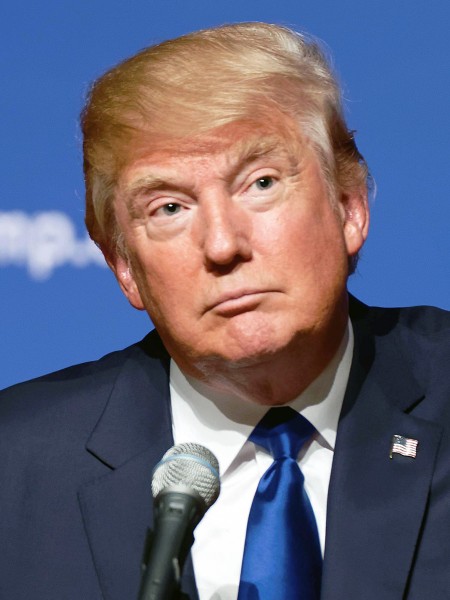 If, as expected, the new president adopts an expansionary fiscal policy, with tax cuts and increased government spending on infrastructure projects, this will stimulate the economy and put upward pressure on inflation. It could also mean that the Fed will raise interest rates again more quickly. Indeed, the FOMC indicated that it expects three rate rises in 2017 rather than the two it predicted in September.
If, as expected, the new president adopts an expansionary fiscal policy, with tax cuts and increased government spending on infrastructure projects, this will stimulate the economy and put upward pressure on inflation. It could also mean that the Fed will raise interest rates again more quickly. Indeed, the FOMC indicated that it expects three rate rises in 2017 rather than the two it predicted in September.
However, just how much and when the Fed will raise interest rates again is highly uncertain. Future monetary policy measures will only become more predictable when Trump’s policies and their likely effects become clearer.
Articles
US Federal Reserve raises interest rates and flags quicker pace of tightening in 2017 Independent, Ben Chu (14/12/16)
US Federal Reserve raises interest rates: what happens next? The Telegraph, Szu Ping Chan (15/12/16)
Holiday traditions: The Fed finally manages to lift rates in 2016 The Economist (14/12/16)
US raises key interest rate by 0.25% on strengthening economy BBC News (14/12/16)
Fed Raises Key Interest Rate, Citing Strengthening Economy The New York Times, Binyamin Appelbaum (14/12/16)
US dollar surges to 14-year high as Fed hints at three rate hikes in 2017 The Guardian, Martin Farrer and agencies (15/12/16)
Questions
- What determines the stance of US monetary policy?
- How does fiscal policy impact on market interest rates and monetary policy?
- What effect does a rise in interest rates have on exchange rates and the various parts of the balance of payments?
- What effect is a rise in US interest rates likely to have on other countries?
- What is meant by ‘forward guidance’ in the context of monetary policy? What are the benefits of providing forward guidance?
- What were the likely effects on the US stock market of the announcement by the FOMC?
- Following the FOMC announcement, two-year US Treasury bond yields rose to 1.231%, the highest since August 2009. Explain why.
- For what reason does the FOMC believe that the US economy is already expanding at roughly the maximum sustainable pace?
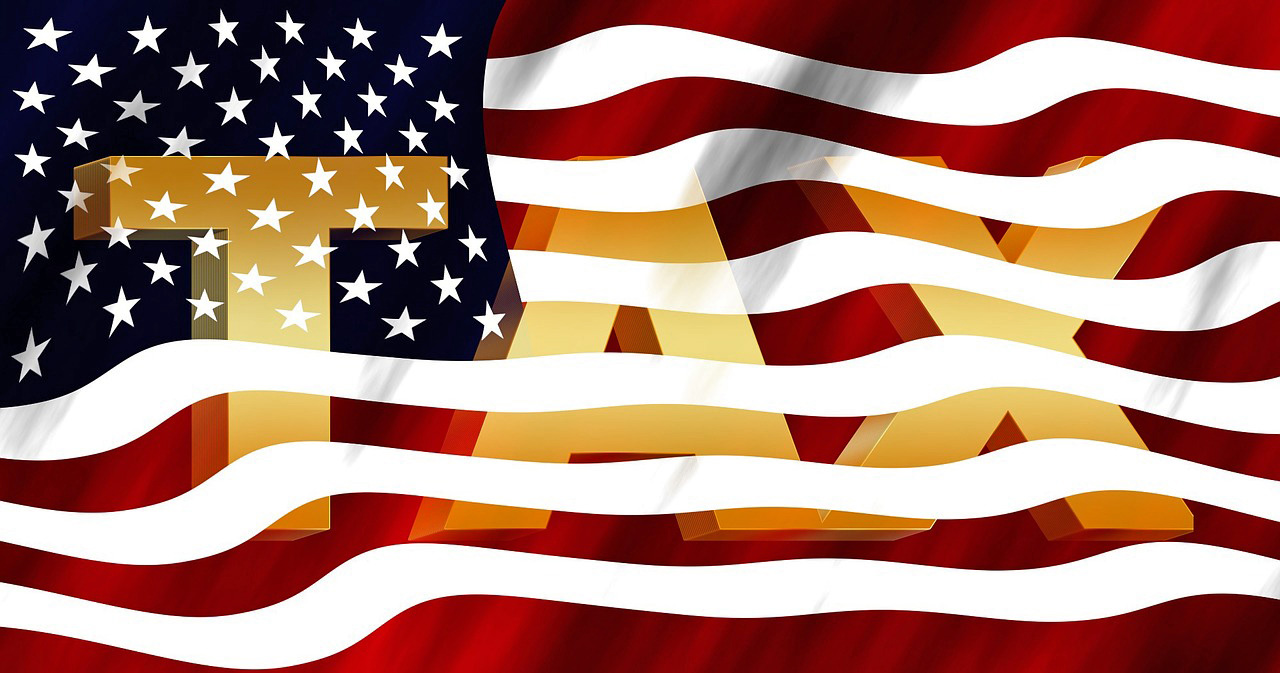
The first article below, from The Economist, examines likely macroeconomic policy under Donald Trump. He has stated that he plans to cut taxes, including reducing the top rates of income tax and reducing taxes on corporate income and capital gains. At the same time he has pledged to increase infrastructure spending.
This expansionary fiscal policy is unlikely to be accompanied by accommodating monetary policy. Interest rates would therefore rise to tackle the inflationary pressures from the fiscal policy. One effect of this would be to drive up the dollar and therein lies significant risks.
The first is that the value of dollar-denominated debt would rise in foreign currency terms, thereby making it difficult for countries with high levels of dollar debt to service those debts, possibly leading to default and resulting international instability. At the same time, a rising dollar may encourage capital 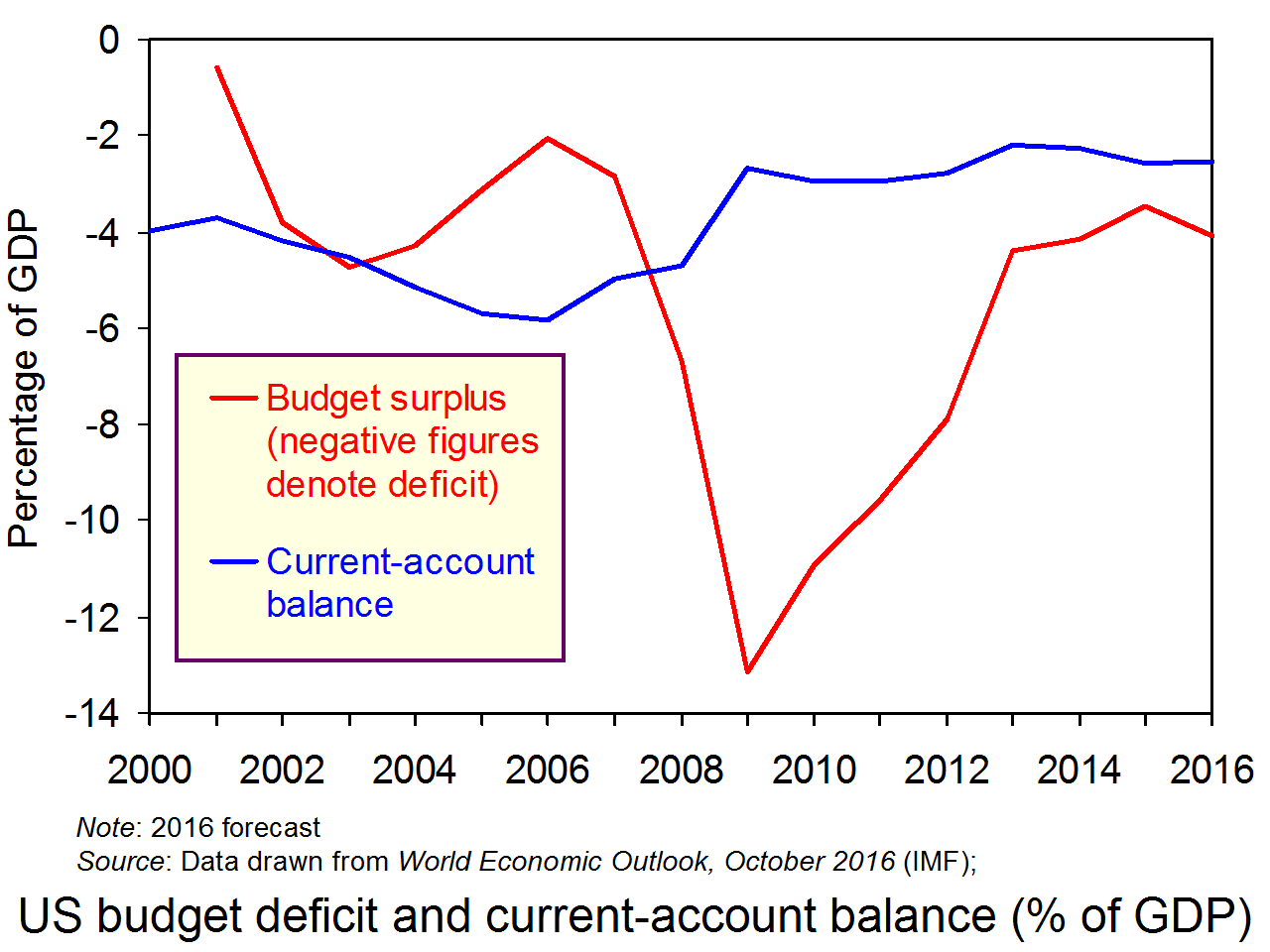 flight from weaker countries to the US (see The Economist article, ‘Emerging markets: Reversal of fortune’).
flight from weaker countries to the US (see The Economist article, ‘Emerging markets: Reversal of fortune’).
The second risk is that a rising dollar would worsen the US balance of trade account as US exports became less competitive and imports became more so. This may encourage Donald Trump to impose tariffs on various imports – something alluded to in campaign speeches. But, as we saw in the blog, Trump and Trade, “With complex modern supply chains, many products use components and services, such as design and logistics, from many different countries. Imposing restrictions on imports may lead to damage to products which are seen as US products”.
The third risk is that the main beneficiaries of Trump’s likely fiscal measures will be the rich, who would end up paying significantly less tax. With all the concerns from poor Americans, including people who voted for Trump, about growing inequality, measures that increase this inequality are unlikely to prove popular.
Articles
That Eighties show The Economist, Free Exchange (19/11/16)
The unbearable lightness of a stronger dollar Financial Times (18/11/16)
Questions
- What should the Fed’s response be to an expansionary fiscal policy?
- Which is likely to have the larger multiplier effect: (a) tax revenue reductions from cuts in the top rates of income; (b) increased government spending on infrastructure projects? Explain your answer.
- Could Donald Trump’s proposed fiscal policy lead to crowding out? Explain.
- What would protectionist policies do to (a) the US current account and (b) dollar exchange rates?
- Why might trying to protect US industries from imports prove difficult?
- Why might Trump’s proposed fiscal policy lead to capital flight from certain developing countries? Which types of country are most likely to lose from this process?
- Go though each of the three risks referred to in The Economist article and identify things that the US administration could do to mitigate these risks.
- Why may the rise in the US currency since the election be reversed?
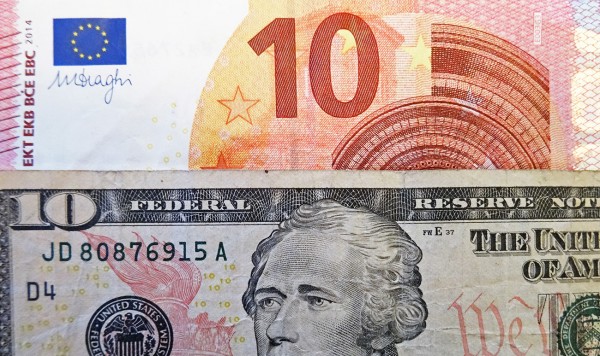 The Federal Reserve chair, Janet Yellen, has been giving strong signals recently that the US central bank will probably raise interest rates at its December 16 meeting or, if not then, early in 2016. ‘Ongoing gains in the labor market’ she said, ‘coupled with my judgement that longer-term inflation expectations remain reasonably well anchored, serve to bolster my confidence in a return of inflation to 2%.’ This, as for many other central banks, is the target rate of inflation.
The Federal Reserve chair, Janet Yellen, has been giving strong signals recently that the US central bank will probably raise interest rates at its December 16 meeting or, if not then, early in 2016. ‘Ongoing gains in the labor market’ she said, ‘coupled with my judgement that longer-term inflation expectations remain reasonably well anchored, serve to bolster my confidence in a return of inflation to 2%.’ This, as for many other central banks, is the target rate of inflation.
In anticipation of a rise in US interest rates, the dollar has been appreciating. Its (nominal) exchange rate index has risen by 24% since April 2014 (see chart below).
In the light of the sluggish eurozone economy, the ECB president, Mario Draghi, has been taking a very different stance. He has indicated that he stands ready to cut interest rates further and increase quantitative easing.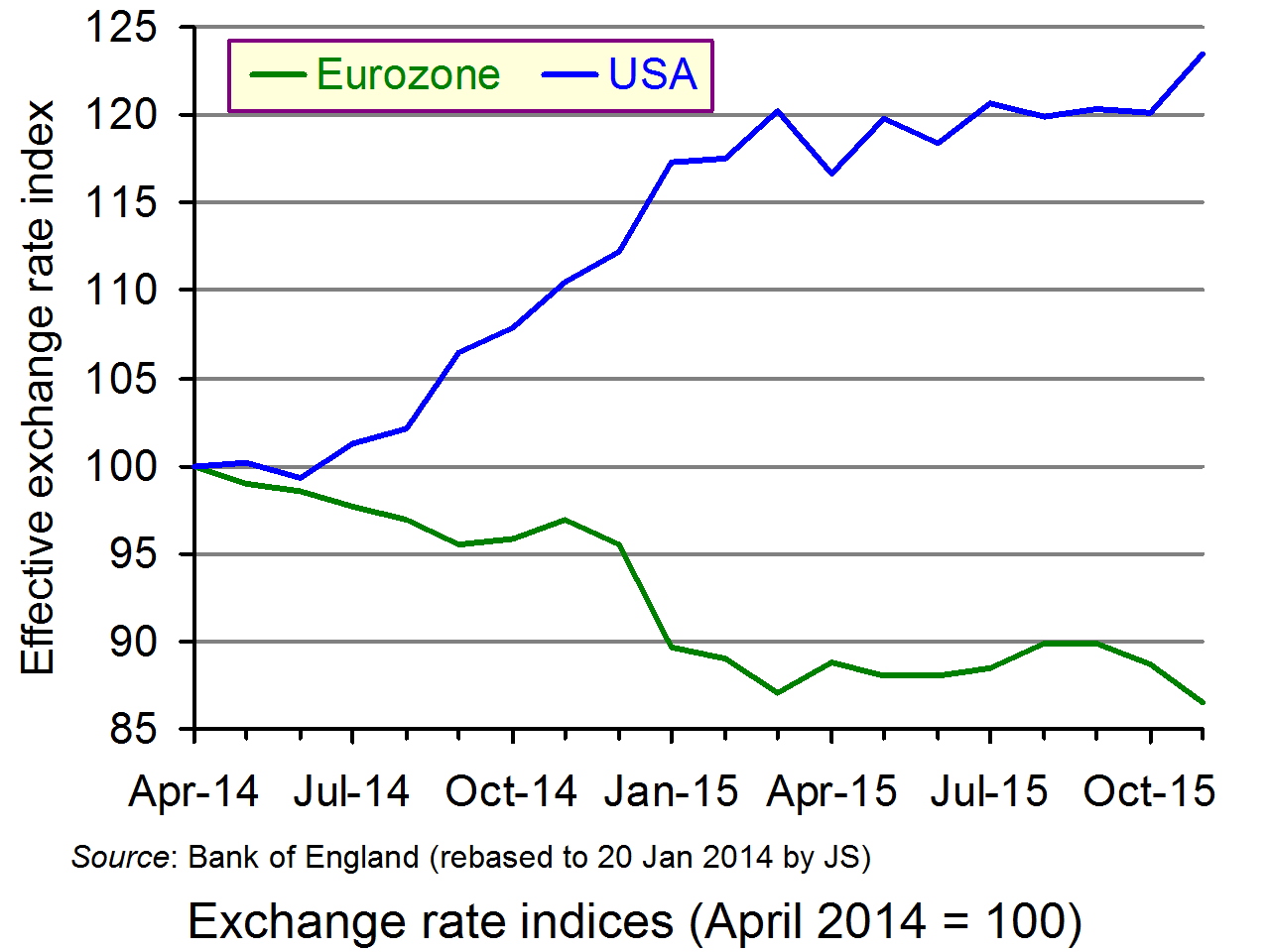 At the meeting on 3 December, the ECB did just that. It announced a further cut in the deposit rate, from –0.2 to –0.3 and an extension of the €60 billion per month QE programme from September 2016 to March 2017 (bringing the total by that time to €1.5 trillion – up from €1.1 trillion by September 2016).
At the meeting on 3 December, the ECB did just that. It announced a further cut in the deposit rate, from –0.2 to –0.3 and an extension of the €60 billion per month QE programme from September 2016 to March 2017 (bringing the total by that time to €1.5 trillion – up from €1.1 trillion by September 2016).
Stock market investors had been expecting more, including an increase in the level of monthly asset purchases above €60 billion. Consequently stock markets fell. Both the German DAX and the French CAC 40 stock market indices fell by 3.6%. The euro also appreciated against the dollar by 2.7% on the day of the announcement. Nevertheless, since April 2014, the euro exchange rate index has fallen by 13%. Against the US dollar, the euro has depreciated by a massive 31%.
So what will be the consequences of the very different monetary policies being pursued by the Fed and the ECB? Are they simply the desirable responses to a lack of convergence of the economic performance of the US and eurozone economies? In other words, will they help to bring greater convergence between the two economies?
Or will the desirable effects of convergence be offset by other undesirable effects for the USA and the eurozone and also for the rest of the world?
|
|
| • |
Will huge amounts of dollar-denominated debt held by many emerging economies make it harder to service these debts with an appreciating dollar? |
| • |
How much will US exporters suffer from the dollar’s rise and what will the US authorities do about it? |
| • |
Will currency volatility lead to currency wars and, if so, what will be their economic effects? |
| • |
Will the time lags involved in the effects of the continuing programme of QE in the eurozone eventually lead to overheating? Already euro money supply is rising, on both narrow and broad measures. |
The following articles address these issues.
Articles
The Fed and the ECB: when monetary policy diverges The Guardian, Mohamed El-Erian (2/12/15)
European stocks slide after ECB dashes hopes of major QE expansion The Guardian, Heather Stewart and Graeme Wearden (3/12/15)
Mario Draghi riles Germany with QE overkill The Telegraph, Ambrose Evans-Pritchard (3/12/15)
How the eurozone missed its shot at a recovery The Telegraph, Peter Spence (3/12/15)
Yellen Signals Economy Nearly Ready for First Interest-Rate Hike Bloomberg, Christopher Condon (3/12/15)
Exchange rate data
Effective exchange rate indices Bank for International Settlements
Exchange rates Bank of England
Questions
- What would be the beneficial effects to the US and eurozone economies of their respective monetary policies?
- Explain the exchange rate movements that have taken place between the euro and the dollar over the past 19 months. How do these relate to the various parts of the balance of payments accounts of the two economies?
- Is it possible for the USA to halt the rise in the dollar while at the same time raising interest rates? Explain.
- Why are some members of the ECB (e.g. the German and Dutch) against expanding QE? Assess their arguments.
- What will be the impact of US and eurozone monetary policies on emerging economies?
- What will be the impact of US and eurozone monetary policies on the UK?
- Why did the euro appreciate after the Mario Draghi’s press statement on 3 December? What has happened to the dollar/euro exchange rate since and why?
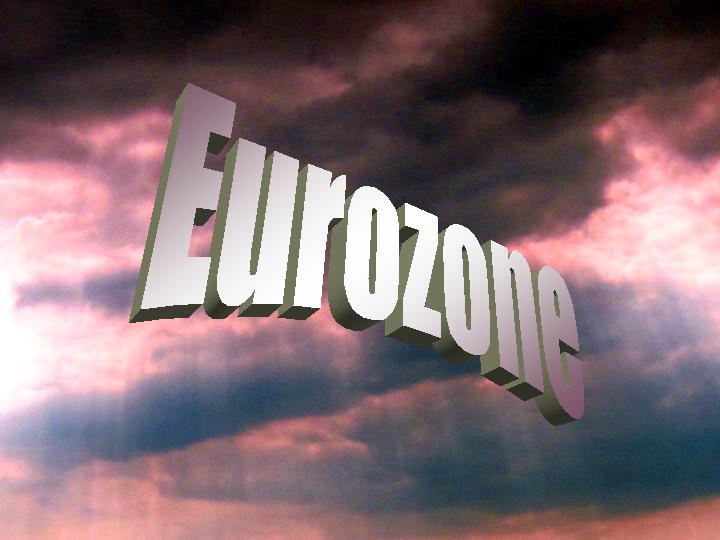 The eurozone is certainly in trouble and, despite the efforts of world leaders to create confidence, it appears that most announcements are having the opposite effect. The risk of deflation has now emerged to be very true; the powerhouse of Europe ‘needs to do more’ and the euro has fallen following Mario Draghi’s recent comments. So, just how bad are things in the eurozone?
The eurozone is certainly in trouble and, despite the efforts of world leaders to create confidence, it appears that most announcements are having the opposite effect. The risk of deflation has now emerged to be very true; the powerhouse of Europe ‘needs to do more’ and the euro has fallen following Mario Draghi’s recent comments. So, just how bad are things in the eurozone?
Mario Draghi suggested that as a means of stimulating the eurozone economies, a process of quantitative easing may soon need to begin. However, rather than reassuring investors that action was being taken to improve the economic performance in the region, it appears to have had the opposite effect. Following his comments, the euro fell to its lowest level since the middle of 2010.
Quantitative easing has seen much use in the aftermath of the financial crisis and the aim in the eurozone would be to put a stop to the continuing price decreases. The eurozone has now entered deflation and, while the aim of this economic area has always been low prices, deflation is not good news. The downward pressure on prices has been largely driven by oil prices falling and prices in other areas remaining relatively stable.
Quantitative easing would inject money into the eurozone, thus creating growth (or at least that’s the idea) and pushing up prices. One of Mario Draghi’s comments was:
‘We are making technical preparations to alter the size, pace and composition of our measures in early 2015.’
 So, while it’s not certain that the QE policy will be used, it seems pretty likely, especially as this policy has been floating around for almost a year.
So, while it’s not certain that the QE policy will be used, it seems pretty likely, especially as this policy has been floating around for almost a year.
A key question is, will it work? The quantity theory of money does suggest that an increase in the money supply will lead to inflationary pressures, unless its velocity of circulation falls. But will it actually stimulate aggregate demand and economic growth? If there is more money in the banking system and hence more money available for lending then it may well stimulate investment and consumption. However, if consumers and firms are not confident about the effectiveness of the policy or about the future of the economy, then will the fact that more money is available for lending actually encourage them to borrow? In this case will there merely be a fall in the velocity of circulation?
The comments by Mario Draghi have also caused the euro to fall to its lowest level since 2010. The graph included in the CNBC article provides an interesting view of the path of the euro. Marc Chandler, from Brown Brothers Harriman said:
‘I’d say there’s a good chance it [the euro] gets there [parity with the dollar] before the election next November (2016) … We know the Fed’s going to be raising rates sooner or later, and the ECB is going to be easing sooner or later. I just see a steady grind lower.’
The outlook of the euro therefore doesn’t look too good by all accounts. It is now a waiting game to see if the policy of quantitative easing is implemented and whether or not it has the desired effect. The following articles consider this topic.
Eurozone economy slows further BBC News (6/1/15)
Eurozone falls into deflation for first time since October 2009 Financial Times, Claire Jones (7/1/15)
Eurozone officially falls into deflation, piling pressure on ECB The Telegraph, Marion Dakers (7/1/15)
Eurozone consumer prices fall for first time in five years Nasdaq, Brian Blackstone and Paul Hannon (7/1/15)
Draghi comments send euro to lowest level since 2010 BBC News (2/1/15)
Oil slump drags Eurozone into deflation The Guardian, Graeme Wearden (7/1/15)
Eurozone prices fall more than expected in December Reuters (7/1/15)
Eurozone lurches into deflation after oil price crashes Independent, Russell Lynch (7/1/15)
German inflation hits five-year low as Eurozone prepares for QE The Telegraph, Mehreen Khan (5/1/15)
Euro slide could take it to parity with dollar CNBC, Patti Domm (7/1/15)
Questions
- Why is deflation a cause for concern when normally the main problem is inflation that is too high?
- What is the quantity theory of money and how does it suggest an increase in the money supply will affect prices?
- If quantitative easing is implemented, is it likely to have the desired effect? Explain why or why not.
- Why has the euro been affected by Mario Draghi’s comments? Use a diagram to help your explanation.
- How will quantitative easing help to stimulate economic growth across the Eurozone? Are there any other policies that would be effective?
- Oil prices have had a big influence on the deflationary pressures in the Eurozone. If oil prices increased again, would this be sufficient to create inflation?
 On 14 December, the US Federal Reserve announced that its 10-person Federal Open Market Committee (FOMC) had unanimously decided to raise the Fed’s benchmark interest rate by 25 basis points to a range of between 0.5% and 0.75%. This is the first rise since this time last year, which was the first rise for nearly 10 years.
On 14 December, the US Federal Reserve announced that its 10-person Federal Open Market Committee (FOMC) had unanimously decided to raise the Fed’s benchmark interest rate by 25 basis points to a range of between 0.5% and 0.75%. This is the first rise since this time last year, which was the first rise for nearly 10 years. If, as expected, the new president adopts an expansionary fiscal policy, with tax cuts and increased government spending on infrastructure projects, this will stimulate the economy and put upward pressure on inflation. It could also mean that the Fed will raise interest rates again more quickly. Indeed, the FOMC indicated that it expects three rate rises in 2017 rather than the two it predicted in September.
If, as expected, the new president adopts an expansionary fiscal policy, with tax cuts and increased government spending on infrastructure projects, this will stimulate the economy and put upward pressure on inflation. It could also mean that the Fed will raise interest rates again more quickly. Indeed, the FOMC indicated that it expects three rate rises in 2017 rather than the two it predicted in September.




